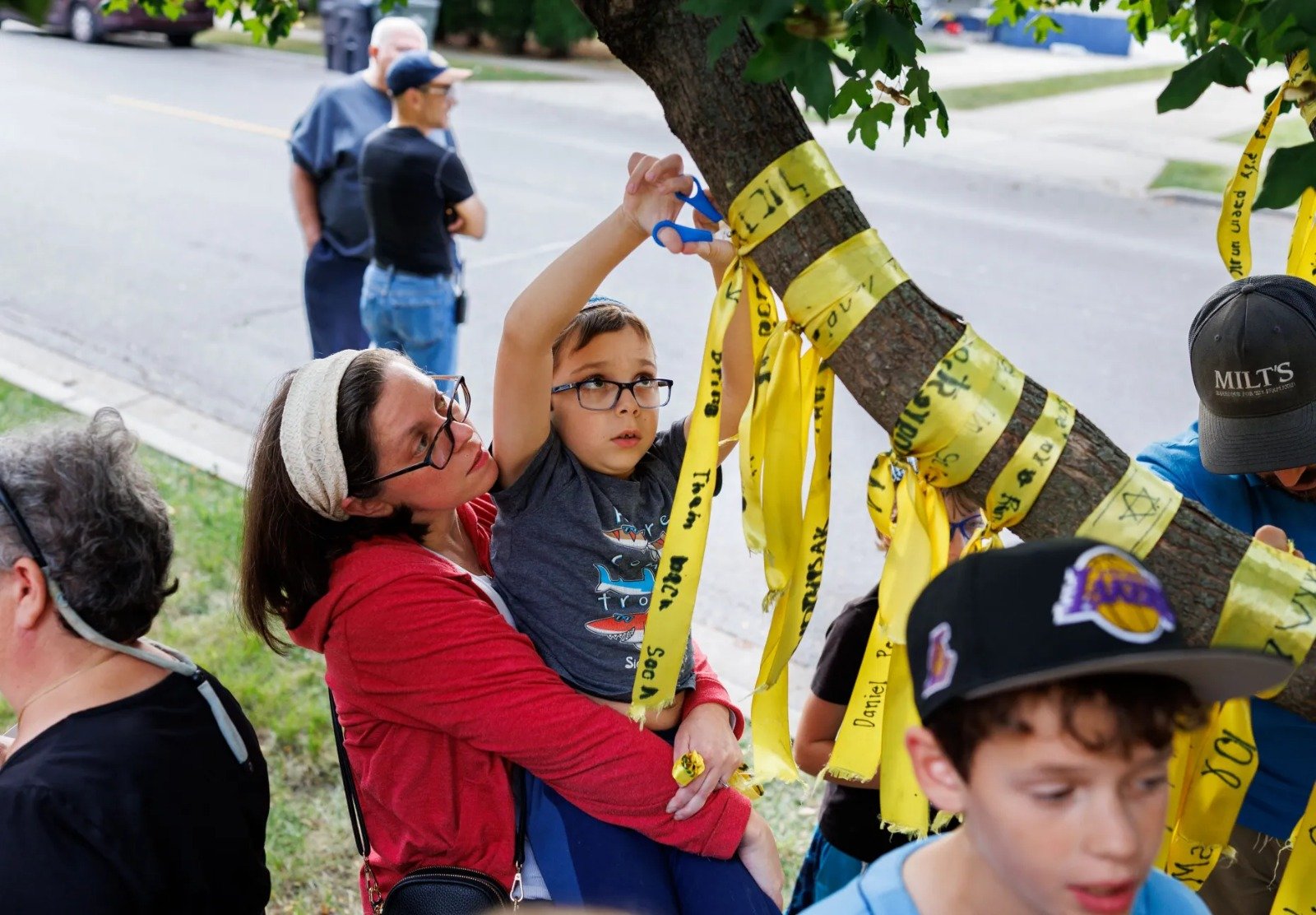


JNS
“There was a tremendous amount of joy and emotional release, but also a palpable sense of loss,” Rabbi Ari Hart, of Skokie, Ill., told JNS.
As news spread at the end of the Sukkot holiday of the liberation of the final living hostages, whom the Hamas terror group held in Gaza, synagogues across the United States marked the moment with quiet ceremonies that mixed relief and mourning.
At Skokie Valley Agudath Jacob Synagogue, a Modern Orthodox shul in the Chicago area, some 65 congregants gathered on the eve of the Shemini Atzeret holiday to remove yellow ribbons which had been affixed to trees outside the synagogue for almost two years.
“Everyone was excited,” congregant Bryan Gryka, general manager and executive chef of the kosher eatery Milt’s Barbecue for the Perplexed who attended with his 9-year-old son, told JNS. “They had yellow ribbons with hostage names on them, and they were removing them as the hostages were released. They left the last 20 for bodies that had to be released.”
The synagogue’s senior rabbi, Ari Hart, told JNS that the moment was one of “a lot of different emotions.”
“There was definitely joy and elation having seen the videos of hostages reunited with their families,” he said. “There was a tremendous amount of joy and emotional release, but also a palpable sense of loss: loss for the families, whose hostages had not yet come home, for the families who lost people along the way and for all the loss and pain of the past two years.”
The synagogue called its ceremony a “ribbon release” rather than a cutting, according to the rabbi, emphasizing that “ribbon cutting has a very different connotation.”
Rather than discarding signs and ribbons, congregants brought the symbols inside the synagogue.
“We brought all the posters inside and have them on a display table,” Hart said. “It didn’t feel right to throw them out. We told people to bring lawn signs, anything they had.”
“Now it’s a place where everyone can put the signs and ribbons to pay respect,” he said. “There’s a beautiful display in the lobby.”
Hart noted that the act of taking down the symbols after Israel liberated the hostages resembles, in a superficial way, the manner in which vandals have torn hostage posters down and defaced them. The motivation could hardly be more different, he said.
“I would strongly reject a comparison between what vandals and antisemites did and transitioning, which is what we did,” he told JNS. “The reason you put up hostage pictures is so the world wouldn’t forget. Now, thank God, that voice is no longer needed. That chapter is over.”
 Congregants at Skokie Valley Agudath Jacob Synagogue, a Modern Orthodox shul in the Chicago area, remove yellow hostage ribbons after the final living hostages were liberated from Gaza, Oct. 13, 2025. Photo by Ari Hart, senior rabbi of the synagogue.
Congregants at Skokie Valley Agudath Jacob Synagogue, a Modern Orthodox shul in the Chicago area, remove yellow hostage ribbons after the final living hostages were liberated from Gaza, Oct. 13, 2025. Photo by Ari Hart, senior rabbi of the synagogue.
‘Depositing our grief’
For many participants at the Skokie shul, the day felt like an emotional turning point but not closure.
“It was both uneasy but also exciting,” Gryka told JNS. “A lot of optimism but a lot of pain. Two years of emotions pent up. It felt really weird taking them down, but it seemed to be the right move.”
In Chevy Chase, Md., Ohr Kodesh Congregation held a similar ceremony during the holiday. Congregants at the Conservative congregation were asked to remove the yellow hostage necklaces many had worn since Oct. 7 and place them in a communal basket.
“The idea was that because the hostages were released, we wouldn’t wear them,” Paula Shoyer, a pastry chef who goes by the “kosher baker” and a member of the congregation, told JNS. “They asked people to take them off and put them collectively in a basket, which felt like depositing our grief.”
The basket sat on a chair that had been at the synagogue’s “empty table,” a display that included photos of hostages and yellow ribbons for nearly two years.
“My friend Sarah Feinberg had set up the table,” Shoyer told JNS. “She took off the hostage photos and then placed the basket on the chair.”
For Shoyer, the day carried an emotional mix of relief and remembrance. “The day and whole chag was emotional,” she said, using the Hebrew word for “holiday.”
“We were all on edge until they were actually released and then so happy but also heartbroken that so many were killed in captivity and on Oct. 7,” she said.
Back in Skokie, Gryka said that the mood at his synagogue was “overall happy,” as congregants read the names of all who were released, including those who had died. Someone brought a shofar, and songs broke out among the crowd.
The ceremony marked an essential transition for Hart’s community, the rabbi told JNS.
“Gatherings and ceremonies are important,” he said. “It felt like an important emotional and spiritual transition, and for those who wanted to experience it together, it was powerful to mark that moment.”
“We had gathered together so many times to march and pray,” he added. “It felt like closing the circle and moving to the next chapter.”